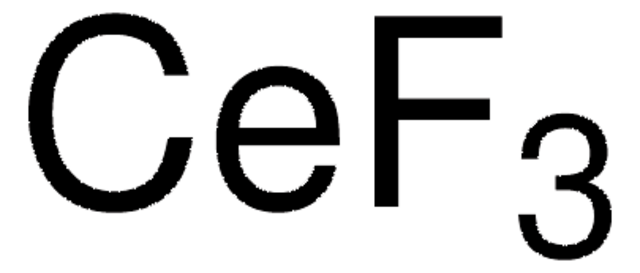450030
Strontium fluoride
anhydrous, powder, 99.9% trace metals basis
Synonym(s):
Strontium difluoride
Sign Into View Organizational & Contract Pricing
All Photos(2)
About This Item
Linear Formula:
SrF2
CAS Number:
Molecular Weight:
125.62
EC Number:
MDL number:
UNSPSC Code:
12352302
PubChem Substance ID:
NACRES:
NA.23
Recommended Products
grade
anhydrous
Quality Level
Assay
99.9% trace metals basis
form
powder
impurities
≤1500.0 ppm Trace Metal Analysis
bp
2489 °C (lit.)
mp
>1400 °C (lit.)
density
4.24 g/mL at 25 °C (lit.)
SMILES string
F[Sr]F
InChI
1S/2FH.Sr/h2*1H;/q;;+2/p-2
InChI key
FVRNDBHWWSPNOM-UHFFFAOYSA-L
Looking for similar products? Visit Product Comparison Guide
Related Categories
General description
Strontium fluoride(SrF2) is a wideband gap anhydrous solid with excellent optical properties. It has a low refractive index, high transmission in the infrared and ultraviolet spectral range, and extremely low solubility in water. It is widely used as a coating material for lenses, optical windows, and prisms.
Application
Strontium fluoride can be used:
- To produce an ultra-thin layer on the ZnO electron transport layer in inverted polymer solar cells. SrF2 thin layer enhances electron extraction efficiency and reduces carrier recombination loss, remarkably improving photovoltaic performance.
- To prepare a highly luminescent Ce3+-doped SrF2 nanophosphor for dye-sensitized solar cells. These nanophosphors help to enhance light harvesting and power conversion efficiencies.
- To fabricate non-toxic and dopant-free electron-selective contact for silicon solar cells. This contact has exceptional stability and thickness tolerance.
Storage Class Code
11 - Combustible Solids
WGK
WGK 2
Flash Point(F)
Not applicable
Flash Point(C)
Not applicable
Personal Protective Equipment
dust mask type N95 (US), Eyeshields, Gloves
Choose from one of the most recent versions:
Already Own This Product?
Find documentation for the products that you have recently purchased in the Document Library.
Strontium fluoride and zinc oxide stacked structure as an interlayer in high-performance inverted polymer solar cells
Shuai Huang, et al.
ACS Applied Materials & Interfaces, 11, 2149-2158 (2018)
Bikramjit Basu et al.
Journal of biomedical materials research. Part B, Applied biomaterials, 103(6), 1168-1179 (2014-10-11)
One of the desired properties for any new biomaterial composition is its long-term stability in a suitable animal model and such property cannot be appropriately assessed by performing short-term implantation studies. While hydroxyapatite (HA) or bioglass coated metallic biomaterials are
Kan Usuda et al.
Biological trace element research, 167(1), 84-90 (2015-03-10)
Various fluoride compounds are widely used in industry. The present risk assessment study was conducted using a series of inorganic binary fluorides of the type XFn, where X(n) = Na(+), K(+), Li(+), Mg(2+), Ca(2+), Sr(2+), Ba(2+), Al(3+), Nd(3+), La(3+), Ce(3+), Sm(3+), Gd(3+)
Our team of scientists has experience in all areas of research including Life Science, Material Science, Chemical Synthesis, Chromatography, Analytical and many others.
Contact Technical Service








